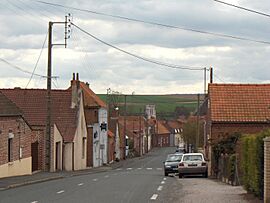Thérouanne facts for kids
Quick facts for kids
Thérouanne
Terenburg
|
||
|---|---|---|

The centre of Thérouanne
|
||
|
||
| Country | France | |
| Region | Hauts-de-France | |
| Department | Pas-de-Calais | |
| Arrondissement | Saint-Omer | |
| Canton | Fruges | |
| Intercommunality | Pays de Saint-Omer | |
| Area
1
|
8.37 km2 (3.23 sq mi) | |
| Population
(2021)
|
1,109 | |
| • Density | 132.50/km2 (343.2/sq mi) | |
| Time zone | UTC+01:00 (CET) | |
| • Summer (DST) | UTC+02:00 (CEST) | |
| INSEE/Postal code |
62811 /62129
|
|
| Elevation | 31–116 m (102–381 ft) (avg. 38 m or 125 ft) |
|
| 1 French Land Register data, which excludes lakes, ponds, glaciers > 1 km2 (0.386 sq mi or 247 acres) and river estuaries. | ||
Thérouanne is a small town in the Pas-de-Calais area of France. It is located about 10 kilometers west of Aire-sur-la-Lys. It is also about 13 kilometers south of Saint-Omer. The town sits where the D 157 and D 341 roads meet. The Lys River also flows through Thérouanne.
Contents
People Living in Thérouanne
The number of people living in Thérouanne has changed over time. In 1968, there were 877 people. By 2017, the population had grown to 1115 people. In 2021, about 1109 people lived there.
A Look Back in Time: History of Thérouanne
Thérouanne has a very long history. When the ancient Gauls lived here, the town was called Tarwanna or Tervanna. It was the main city for a tribe called the Morini. Later, the Romans took over Gaul. They also made Thérouanne the capital of their local district.
There are different ideas about where the name Thérouanne comes from. Some say it was named after a founder, "Lucius Tauruannus." Others think it means "The land of Oats."
In the 600s, a religious leader named Saint Audomar (also called Saint Omer) started a special church area here. It was called the diocese of Thérouanne. During the Middle Ages, this diocese controlled a large area. This included important cities like Arras and Ypres. Because of this control, the church built a huge cathedral. It was one of the biggest in France at that time.
In 1303, the town was burned by forces from Flanders during a war.
In 1513, Emperor Maximilian and Henry VIII of England captured Thérouanne from the French. This happened after a battle known as the Battle of the Spurs.
Later, in 1553, Charles V attacked Thérouanne. He was angry because of a defeat by the French. After he captured the city, he ordered it to be completely destroyed. The roads were broken up, and the land was plowed. Only a small village outside the city walls was left. This village later took the name Thérouanne. Today, only a large statue of Christ remains from the old cathedral.
Because the main church area was destroyed, new church districts were created. These included Saint-Omer and Ypres.
Thérouanne is also located on the Via Francigena. This was an old road used by pilgrims traveling to Rome.
Cool Places to See
- The Church of Saint Martin was rebuilt in the 1800s. It stands on the site of a much older church. It was updated in 2000 and 2001.
- The Archaeological Museum and Site shows what is left of the old medieval city. You can see parts of buildings from long ago.
- The ruins of the Abbey of St. Jean-du-Mont are also here. This includes parts of a Gothic cathedral. It has remains from the 600s and a Carolingian building. These ruins are protected as a historical monument.
Sister Cities
Thérouanne has a special friendship with Hamstreet. Hamstreet is a town in Kent, England.
Famous People from Thérouanne
- Gérard Houllier was born in Thérouanne. He became a well-known football (soccer) manager.
- Hugh of Saint Omer (died 1106) was a important leader in the Middle Ages. He was known as the Prince of Galilee.
Thérouanne in Books
- The town appears as Taruenna in a book by Matthew Kneale. It is about an English journey to Rome.
- In the book Wolf Hall by Hilary Mantel, Thérouanne is mentioned. The character Thomas Cromwell calls it a "dog hole" in a speech. This makes Henry VIII upset.
See also
 In Spanish: Thérouanne para niños
In Spanish: Thérouanne para niños




